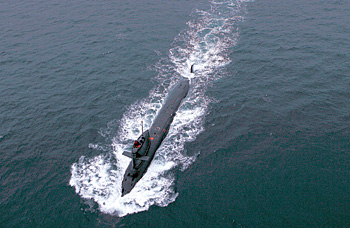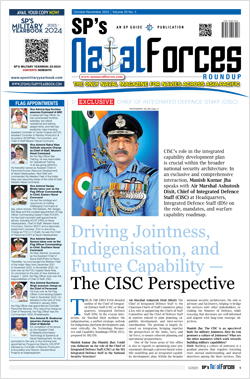INDIAN ARMED FORCES CHIEFS ON OUR RELENTLESS AND FOCUSED PUBLISHING EFFORTS

The insightful articles, inspiring narrations and analytical perspectives presented by the Editorial Team, establish an alluring connect with the reader. My compliments and best wishes to SP Guide Publications.

"Over the past 60 years, the growth of SP Guide Publications has mirrored the rising stature of Indian Navy. Its well-researched and informative magazines on Defence and Aerospace sector have served to shape an educated opinion of our military personnel, policy makers and the public alike. I wish SP's Publication team continued success, fair winds and following seas in all future endeavour!"

Since, its inception in 1964, SP Guide Publications has consistently demonstrated commitment to high-quality journalism in the aerospace and defence sectors, earning a well-deserved reputation as Asia's largest media house in this domain. I wish SP Guide Publications continued success in its pursuit of excellence.
- Global Partners Urged to Tap India's Shipbuilding Potential: Rajnath Singh at Samudra Utkarsh
- All about HAMMER Smart Precision Guided Weapon in India — “BEL-Safran Collaboration”
- India, Germany deepen defence ties as High Defence Committee charts ambitious plan
- G20 Summit: A Sign of Global Fracture
- True strategic autonomy will come only when our code is as indigenous as our hardware: Rajnath Singh
- India–Israel Joint Working Group Meeting on defence cooperation to boost technology sharing and co-development
Cover Story
Need for a Comprehensive and Concerted Approach
No nation can afford a gap of 30 years between inductions of submarines; a weapon platform whose optimum operational life span is about the same. The situation cannot be further compounded by not keeping the available assets combat worthy.

There was a news report in April this year that the Indian Government is in active discussions with Germany to upgrade the existing fleet of four Howaldtswerke-Deutsche Werft (HDW); also known as the Shishumar class submarines. It is understood that this was one of the critical issues discussed during the fifth Indo-German Defence Committee meeting at New Delhi. The same news item went on to elaborate that due to delays in the ongoing Project 75 (Scorpene project), the government has decided to upgrade not only the Shishumar class but also the Russian origin Kilo class, known as the Sindhughosh class.
While this does indicate that the problem of depleting submarine force levels is well understood by the ‘think tank’ and decision-makers, such realisation though essential, is neither sufficient nor a guarantee that the problem at hand will be resolved. For that we require a ‘do tank’—a dedicated team which is multifunctional, multidisciplinary, suitably empowered and unambiguously responsible for the entire upgradation and modernisation programme and any other step which may be considered suitable to mitigate the enormity of the problem.
Submarine Perspective Plan
Around 1997-98, the Naval Headquarters initiated the process of preparing a comprehensive paper highlighting the need for a long-term perspective towards augmenting and sustaining a submarine force level. Termed as the 30-Year Submarine Perspective Plan, it envisaged, among things, two distinct indigenous production lines which were to (at least initially) build submarines which ‘could’ be of two different origins/designs. The delivery schedule of the new submarines was to be dovetailed with the phasing out of the existing Shishumar and Sindhughosh classes of submarines. This would have ensured that the minimum submarine force levels as dictated by the operational planners, was always available.
In November 2002, the paper was approved by the Cabinet Committee on Security (CCS) and the Navy was assured of budgetary support. The two distinct submarine designs which were to be simultaneously (or at least near-simultaneously) built, were christened as Project 75 and Project 75(I). while the former was to utilise the infrastructure available at the Mazagon Dock Limited (MDL), an appropriate shipyard (public or privately owned) was to be identified and developed for the second production line.
Current Status
Project 75: In 2005, the Government of India signed a contract worth $4.6 billion ( Rs. 21,100 crore) with DCNS, France, for building six Scorpene class submarines at MDL. The first submarine was ‘assured’ to roll out in 2012; and the remaining five one per year. Since 2007, a number of problems concerning a wide-range of issues have arisen periodically. These included issues concerning transfer of technology, augmentation of industrial infrastructure and procurement of MDL purchased material, etc. all these have led to price hikes and more importantly, slippage in delivery schedules. In 2011, the Defence Minister accepted in the Parliament that while most issues have been resolved, the first submarine will now be delivered only in 2015. Even if this schedule is met, it will be another year or two before the first platform is fully operational and deployable.
Project 75(I): In 2009-10, the Navy sent out a request for proposal (RFP) for the construction of six conventional submarines at Indian shipyards. Termed as project 75(I), this was to fulfill the stated policy of setting up the second production line for indigenous submarine building. The project is still at the request for information (RFI)/(RFP)/vendor short-listing stage, with at least four active competitors—Rosoboronexport (Russia), DCNS/Amaris (France), HDW (Germany) and Navantia (Spain). Though there has been some progress in the process of identifying an appropriate shipyard, there are still ambiguities on the final decision. Larsen & Toubro has already expressed its skepticism fearing that despite the vast infrastructure created for another project, it may be sidelined. This $11 billion ( Rs. 49,500 crore) project, the so-called ‘mother-of-all defence procurement projects’, is likely to take at least 10 to 12 years to fructify. Given the multitude of peripheral agencies involved in decision-making, the paranoia of financial correctness and transparency, the ‘ghost of HDW kick back’ and the likely aggressive lobbying that the competing firms (and their respective governments) are likely to resort to, this timeframe should be considered as ‘pragmatic and realistic’, and not necessarily pessimistic. It may therefore be prudent to state the ‘bad news’ up front that Project 75(I), as it stands in its present procurement trajectory, is not likely to fructify before 2022-25.
Therefore, none of the submarine platform envisaged under Project 75 and 75(I) is likely to be available for operational deployment before 2017. Even subsequently, the best case scenario is an addition of just one platform each year.





